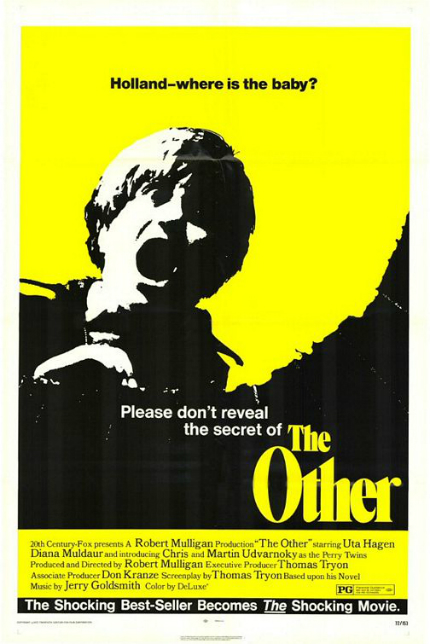70s Rewind: THE OTHER, Sun-dappled Horror in Hiding

A few weeks before five men were arrested for breaking and entering into Democratic National Committee headquarters in the Watergate complex on June 17, 1972. the film version of Tom Tryon's popular novel The Other was released in U.S. theaters.
Soon enough, the country would be embroiled in a political controversy that led to the resignation of President Richard M. Nixon, but in the film world, all was (relatively) quiet. The month before, William Friedkin's The French Connection was presented with five Academy Awards, including Best Picture; "Theme from Shaft" took home the Oscar for Best Song.
The year's early releases included Cabaret, Silent Running, What's Up, Doc?, Slaughterhouse-Five, Pink Flamingos, Fritz the Cat, and The Godfather; the latter dominated the box office when it expanded wide (316 theaters) at the end of March.
In the world of cinematic horror, Freddie Francis' Tales From the Crypt presented five segments of classic terror. In late May, The Possession of Joel Delaney, starring Shirley MacLaine and Perry King, opened two days before The Other. From personal memory, I can easily recall the trailer for the former but not the latter.
Tom Tryon started acting in the early 1950s and eventually starred in Otto Preminger's The Cardinal (1963). By the late 1960s, though, he decided to try his hand at writing and his first novel, The Other, was published in May 1971. It's a lovely, lyrical story, set in rural Connecticut during the 1930s and revolving around adolescent twin brothers: one is good and the other is very, very bad.
In his screenplay, Tryon follows the bare bones of his story, including a twist that is far easier to pull off on the page than on the screen. Indeed, this is probably the fatal flaw of the movie, at least for modern viewers; when the twist arrives, it's treated as a "TA-DA!!" moment, prompting an alert viewer to respond, "Uh-huh, thanks, I already knew that."
But that doesn't render the movie completely ineffective; far from it, especially when viewed through the kinder lens of history. Producer and director Robert Mulligan is probably best remembered nowadays for To Kill a Mockingbird (1962), which also revolved around a young person during the Great Depression. Mulligan was just coming off the nostalgic success of Summer of '42, released the year before; odd as it may sound for a supposed "horror" movie, The Other is related to both, at least in a visual sense.
Robert Surtees, director of photography, earned an Academy Award nomination for Summer of '42 (as well as the same year's The Last Picture Show), and so did film editor Folmar Blangsted. (O. Nicholas Brown also served as film editor.) The filmmakers create an appealing atmosphere of sun-dappled horror in hiding. The horror description may even do the film a disservice, because it's less about terror than it is about the deception of children.
For as far as the audience knows, everything is fine in rural Connecticut as that fateful summer in 1935 begins. Young twin brothers Holland (Martin Udarnoky) and Niles Perry (Chris Udarnoky) enjoy running and playing on the family property, a former working farm, complete with a dusty barn and plenty of hiding places.
Older sister Torrie (Jenny Sullivan) is pregnant and her husband Rider (John Ritter, looking impossibly young) dotes on her. In turn, grandmother Ada (veteran stage actress Uta Hagen in her screen debut) dotes on Niles.
Yet something is vaguely amiss. What happened to the boys' father? Related: what happened to their mother Alexandra (Diana Muldaur), who keeps herself away from everyone else? And why do terrible accidents keep happening to family and friends?
Through much of the running time, the filmmakers keep things looking and feeling pastoral, but eventually the pace becomes more choppy and the tone darkens. It's a genteel, almost polite tone that begins to shade and then dominate the action, as if everyone was too polite to ask direct questions.
The film's age begins to show in that reticence, and whether it wears well is very much up to personal taste. For me, the limitations of most young actors takes a toll; it's rare to find any young person who can satisfy in a leading role, and Mulligan was, upon reflection, quite fortunate to locate very suitable young people to lead both To Kill a Mockingbird and the much later The Man in the Moon, the latter being the screen debut of Reese Witherspoon.
Letting The Other rest in my head for the past week or so, I find that it keeps creeping back into my consciousness. I suspect that's more to do with the ideas about children that Tryon first explored in his novel. As an adult without children (and long past childhood myself), I have no idea when, age-wise, children develop dark ideas that, left unhindered, could flower into monstrous impulses. How do parents (or grandparents, or parental authorities, or adult guardians) know when their children are exercising their imaginations ... or formulating antisocial behaviors?
In The Other, children can be terrifying. Pray they're not yours.
Viewed on Twilight Time Blu-ray, which, unfortunately, now appears to be out of print. 70s Rewind is a column by the writer in which he reflects on movies from his favorite movie decade.







